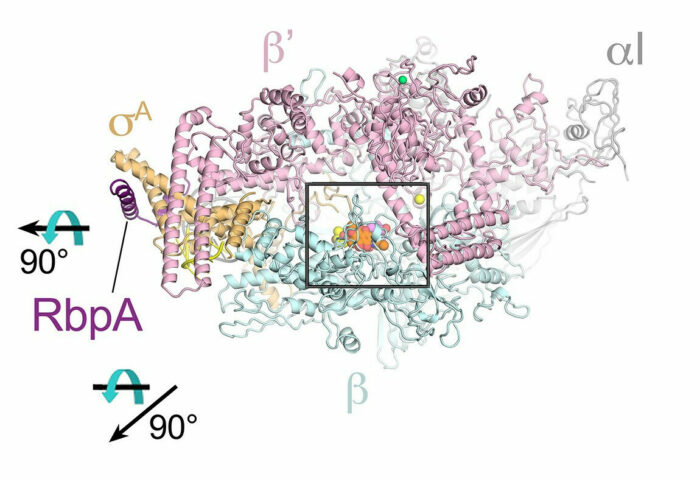Searching for New Ways to Fight Bacterial Resistance
10/08/2018

Overall structural basis for inhibition of rifamycin-resistant bacteria by the rifamycin congener Kang A. The rifamycin scaffold is colored orange in the center of the RNA polymerase enzyme, the target of the antibiotic. [Reprinted under a Creative Commons Attribution 4.0 International (CC BY 4.0) license from Peek, J., et al. 2018. “Rifamycin congeners kanglemycins are active against rifampicin-resistant bacteria via a distinct mechanism,” Nature Communications 9, 4147. DOI:10.1038/s41467-018-06587-2]
The Summary
Natural rifamycin antibiotics and their synthetic derivatives (Rifs) target bacterial RNA polymerases (RNAPs) and are widely used to treat infections, including tuberculosis. The utility of these compounds is threatened by increasing bacterial resistance to the drugs (RifR). As resistance mechanisms found in clinical settings may also occur in natural environments, researchers postulated that bacteria could have evolved to produce rifamycin congeners active against clinically relevant resistance phenotypes.
A survey of soil metagenomes identified a tailoring enzyme-rich family of gene clusters encoding biosynthesis of rifamycin congeners called kanglemycins (Kangs) that display potent in vivo and in vitro activity against the most common clinically relevant RifR mutations. Structural and mechanistic analyses revealed the basis for Kang inhibition of RifR RNAP. Unlike Rifs, Kangs function through a mechanism that includes interfering with 5′-initiating substrate binding.
The results suggest that examining soil microbiomes for new analogues of clinically used antibiotics may uncover metabolites capable of circumventing clinically important resistance mechanisms.
Related Links
- BER Resource: Center for BioMolecular Structure
- Feature Story: Scientists investigate the inhibition of rifamycin derivatives on mycobacteria RNA polymerase
References
J. Peek, M. Lilic, D. Montiel, A. Milshteyn, I. Woodworth, J. B. Biggins, M. A. Ternei, P. Y. Calle, M. Danziger, T. Warrier, K. Saito, N. Braffman, A. Fay, M. S. Glickman, S. A. Darst, E. A. Campbell, S. F. Brady. “Rifamycin congeners kanglemycins are active against rifampicin-resistant bacteria via a distinct mechanism” Nature Communications 9, 4147 (2018). DOI: 10.1038/s41467-018-06587-2
